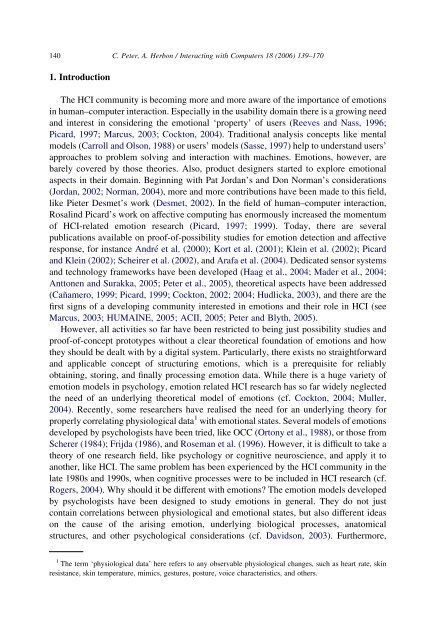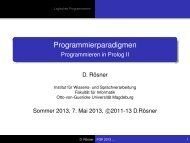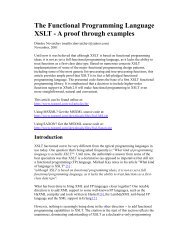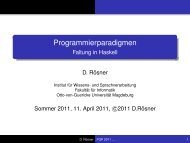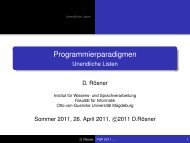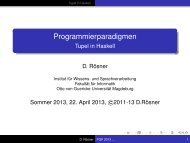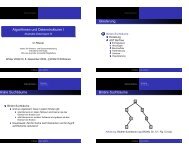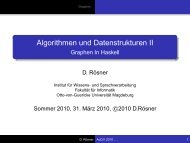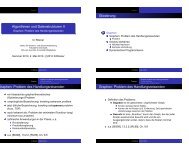Emotion representation and physiology assignments in digital systems
Emotion representation and physiology assignments in digital systems
Emotion representation and physiology assignments in digital systems
You also want an ePaper? Increase the reach of your titles
YUMPU automatically turns print PDFs into web optimized ePapers that Google loves.
140<br />
C. Peter, A. Herbon / Interact<strong>in</strong>g with Computers 18 (2006) 139–170<br />
1. Introduction<br />
The HCI community is becom<strong>in</strong>g more <strong>and</strong> more aware of the importance of emotions<br />
<strong>in</strong> human–computer <strong>in</strong>teraction. Especially <strong>in</strong> the usability doma<strong>in</strong> there is a grow<strong>in</strong>g need<br />
<strong>and</strong> <strong>in</strong>terest <strong>in</strong> consider<strong>in</strong>g the emotional ‘property’ of users (Reeves <strong>and</strong> Nass, 1996;<br />
Picard, 1997; Marcus, 2003; Cockton, 2004). Traditional analysis concepts like mental<br />
models (Carroll <strong>and</strong> Olson, 1988) or users’ models (Sasse, 1997) help to underst<strong>and</strong> users’<br />
approaches to problem solv<strong>in</strong>g <strong>and</strong> <strong>in</strong>teraction with mach<strong>in</strong>es. <strong>Emotion</strong>s, however, are<br />
barely covered by those theories. Also, product designers started to explore emotional<br />
aspects <strong>in</strong> their doma<strong>in</strong>. Beg<strong>in</strong>n<strong>in</strong>g with Pat Jordan’s <strong>and</strong> Don Norman’s considerations<br />
(Jordan, 2002; Norman, 2004), more <strong>and</strong> more contributions have been made to this field,<br />
like Pieter Desmet’s work (Desmet, 2002). In the field of human–computer <strong>in</strong>teraction,<br />
Rosal<strong>in</strong>d Picard’s work on affective comput<strong>in</strong>g has enormously <strong>in</strong>creased the momentum<br />
of HCI-related emotion research (Picard, 1997; 1999). Today, there are several<br />
publications available on proof-of-possibility studies for emotion detection <strong>and</strong> affective<br />
response, for <strong>in</strong>stance André et al. (2000); Kort et al. (2001); Kle<strong>in</strong> et al. (2002); Picard<br />
<strong>and</strong> Kle<strong>in</strong> (2002); Scheirer et al. (2002), <strong>and</strong> Arafa et al. (2004). Dedicated sensor <strong>systems</strong><br />
<strong>and</strong> technology frameworks have been developed (Haag et al., 2004; Mader et al., 2004;<br />
Anttonen <strong>and</strong> Surakka, 2005; Peter et al., 2005), theoretical aspects have been addressed<br />
(Cañamero, 1999; Picard, 1999; Cockton, 2002; 2004; Hudlicka, 2003), <strong>and</strong> there are the<br />
first signs of a develop<strong>in</strong>g community <strong>in</strong>terested <strong>in</strong> emotions <strong>and</strong> their role <strong>in</strong> HCI (see<br />
Marcus, 2003; HUMAINE, 2005; ACII, 2005; Peter <strong>and</strong> Blyth, 2005).<br />
However, all activities so far have been restricted to be<strong>in</strong>g just possibility studies <strong>and</strong><br />
proof-of-concept prototypes without a clear theoretical foundation of emotions <strong>and</strong> how<br />
they should be dealt with by a <strong>digital</strong> system. Particularly, there exists no straightforward<br />
<strong>and</strong> applicable concept of structur<strong>in</strong>g emotions, which is a prerequisite for reliably<br />
obta<strong>in</strong><strong>in</strong>g, stor<strong>in</strong>g, <strong>and</strong> f<strong>in</strong>ally process<strong>in</strong>g emotion data. While there is a huge variety of<br />
emotion models <strong>in</strong> psychology, emotion related HCI research has so far widely neglected<br />
the need of an underly<strong>in</strong>g theoretical model of emotions (cf. Cockton, 2004; Muller,<br />
2004). Recently, some researchers have realised the need for an underly<strong>in</strong>g theory for<br />
properly correlat<strong>in</strong>g physiological data 1 with emotional states. Several models of emotions<br />
developed by psychologists have been tried, like OCC (Ortony et al., 1988), or those from<br />
Scherer (1984); Frijda (1986), <strong>and</strong> Roseman et al. (1996). However, it is difficult to take a<br />
theory of one research field, like psychology or cognitive neuroscience, <strong>and</strong> apply it to<br />
another, like HCI. The same problem has been experienced by the HCI community <strong>in</strong> the<br />
late 1980s <strong>and</strong> 1990s, when cognitive processes were to be <strong>in</strong>cluded <strong>in</strong> HCI research (cf.<br />
Rogers, 2004). Why should it be different with emotions? The emotion models developed<br />
by psychologists have been designed to study emotions <strong>in</strong> general. They do not just<br />
conta<strong>in</strong> correlations between physiological <strong>and</strong> emotional states, but also different ideas<br />
on the cause of the aris<strong>in</strong>g emotion, underly<strong>in</strong>g biological processes, anatomical<br />
structures, <strong>and</strong> other psychological considerations (cf. Davidson, 2003). Furthermore,<br />
1 The term ‘physiological data’ here refers to any observable physiological changes, such as heart rate, sk<strong>in</strong><br />
resistance, sk<strong>in</strong> temperature, mimics, gestures, posture, voice characteristics, <strong>and</strong> others.


